双向无线对讲系统介绍
- 格式:ppt
- 大小:3.67 MB
- 文档页数:51
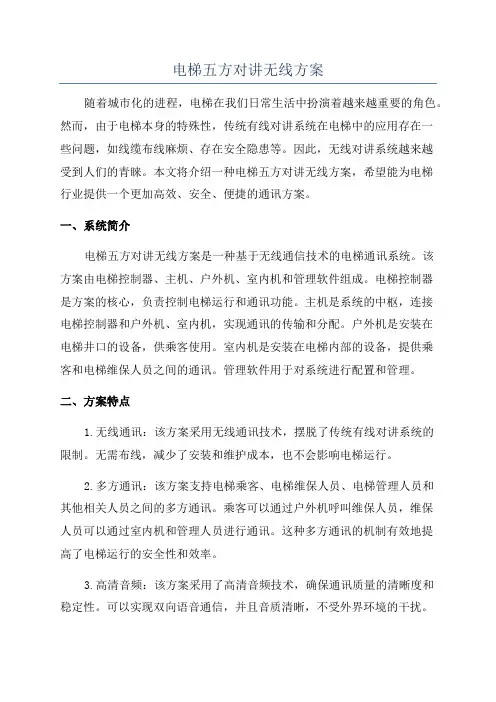
电梯五方对讲无线方案随着城市化的进程,电梯在我们日常生活中扮演着越来越重要的角色。
然而,由于电梯本身的特殊性,传统有线对讲系统在电梯中的应用存在一些问题,如线缆布线麻烦、存在安全隐患等。
因此,无线对讲系统越来越受到人们的青睐。
本文将介绍一种电梯五方对讲无线方案,希望能为电梯行业提供一个更加高效、安全、便捷的通讯方案。
一、系统简介电梯五方对讲无线方案是一种基于无线通信技术的电梯通讯系统。
该方案由电梯控制器、主机、户外机、室内机和管理软件组成。
电梯控制器是方案的核心,负责控制电梯运行和通讯功能。
主机是系统的中枢,连接电梯控制器和户外机、室内机,实现通讯的传输和分配。
户外机是安装在电梯井口的设备,供乘客使用。
室内机是安装在电梯内部的设备,提供乘客和电梯维保人员之间的通讯。
管理软件用于对系统进行配置和管理。
二、方案特点1.无线通讯:该方案采用无线通讯技术,摆脱了传统有线对讲系统的限制。
无需布线,减少了安装和维护成本,也不会影响电梯运行。
2.多方通讯:该方案支持电梯乘客、电梯维保人员、电梯管理人员和其他相关人员之间的多方通讯。
乘客可以通过户外机呼叫维保人员,维保人员可以通过室内机和管理人员进行通讯。
这种多方通讯的机制有效地提高了电梯运行的安全性和效率。
3.高清音频:该方案采用了高清音频技术,确保通讯质量的清晰度和稳定性。
可以实现双向语音通信,并且音质清晰,不受外界环境的干扰。
4.安全稳定:该方案采用了数据加密技术,保证通讯的安全性。
同时,系统具有自动故障检测和报警功能,保证系统的稳定性和可靠性。
5.管理软件:该方案提供了一套完善的管理软件,方便对系统进行配置和管理。
可以实现对用户权限的管理、通讯记录的查看、设备状态的监控等功能。
三、方案应用1.电梯乘客呼叫:电梯乘客可以通过户外机呼叫电梯维保人员,向其报告电梯故障或其他问题。
维保人员可以通过室内机与乘客进行语音交流,提供相应的解决方案。
2.电梯维保通讯:电梯维保人员可以通过室内机和管理人员进行通讯。
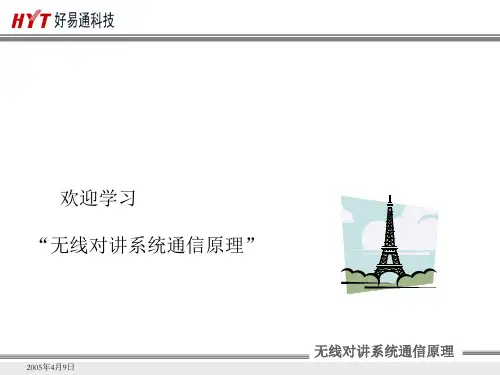
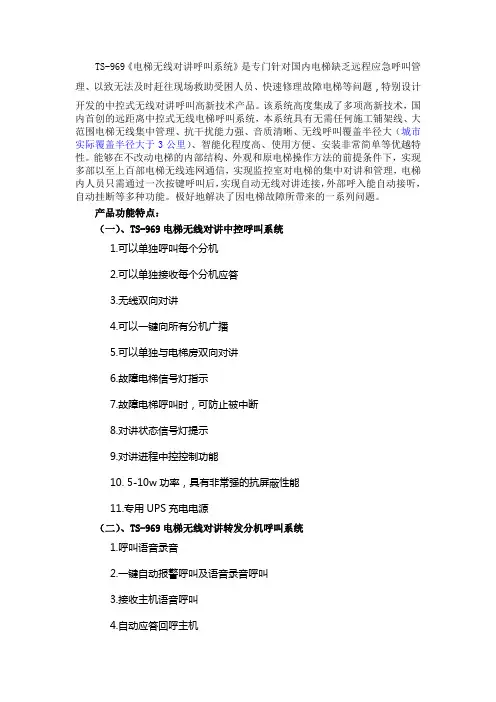
TS-969《电梯无线对讲呼叫系统》是专门针对国内电梯缺乏远程应急呼叫管理、以致无法及时赶往现场救助受困人员、快速修理故障电梯等问题,特别设计开发的中控式无线对讲呼叫高新技术产品。
该系统高度集成了多项高新技术,国内首创的远距离中控式无线电梯呼叫系统,本系统具有无需任何施工铺架线、大范围电梯无线集中管理、抗干扰能力强、音质清晰、无线呼叫覆盖半径大(城市实际覆盖半径大于3公里)、智能化程度高、使用方便、安装非常简单等优越特性。
能够在不改动电梯的内部结构、外观和原电梯操作方法的前提条件下,实现多部以至上百部电梯无线连网通信,实现监控室对电梯的集中对讲和管理,电梯内人员只需通过一次按键呼叫后,实现自动无线对讲连接,外部呼入能自动接听,自动挂断等多种功能。
极好地解决了因电梯故障所带来的一系列问题。
产品功能特点:(一)、TS-969电梯无线对讲中控呼叫系统1.可以单独呼叫每个分机2.可以单独接收每个分机应答3.无线双向对讲4.可以一键向所有分机广播5.可以单独与电梯房双向对讲6.故障电梯信号灯指示7.故障电梯呼叫时,可防止被中断8.对讲状态信号灯提示9.对讲进程中控控制功能10. 5-10w功率,具有非常强的抗屏蔽性能11.专用UPS充电电源(二)、TS-969电梯无线对讲转发分机呼叫系统1.呼叫语音录音2.一键自动报警呼叫及语音录音呼叫3.接收主机语音呼叫4.自动应答回呼主机5.无线双向对讲6.防止反复呼叫7.工程接口齐全8. 5-10w功率,抗屏蔽性能强(三)、TS-969电梯分机有线交换系统1.可以实现多台电梯通过一台电梯无线转发分机与中控对讲呼叫2.通过增加电梯电话,实现监控中心、机房、轿厢、轿顶、坑底五方对讲通话(四)、TS-969电梯无线对讲呼叫系统优势1. 大量节约了昂贵的线路成本;2. 大量节约了线路铺设高额的施工成本;3. 大量节约了由于线路故障、老化等因素而带来的维护成本;4. 完全杜绝了由于铺设线路而带来的对楼宇及道路的破坏;5. 监控中心位置可以根据需要任意调整,无需任何线路调整;6. 整个系统施工极为简单、施工周期短、见效快;7. 无线距离覆盖范围广,在3公里半径内抗干扰能力强、音质清晰。
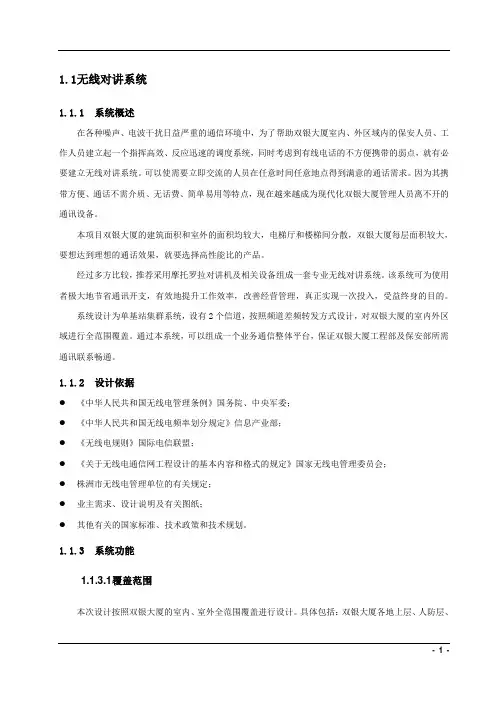
1.1无线对讲系统1.1.1系统概述在各种噪声、电波干扰日益严重的通信环境中,为了帮助双银大厦室内、外区域内的保安人员、工作人员建立起一个指挥高效、反应迅速的调度系统,同时考虑到有线电话的不方便携带的弱点,就有必要建立无线对讲系统。
可以使需要立即交流的人员在任意时间任意地点得到满意的通话需求。
因为其携带方便、通话不需介质、无话费、简单易用等特点,现在越来越成为现代化双银大厦管理人员离不开的通讯设备。
本项目双银大厦的建筑面积和室外的面积均较大,电梯厅和楼梯间分散,双银大厦每层面积较大,要想达到理想的通话效果,就要选择高性能比的产品。
经过多方比较,推荐采用摩托罗拉对讲机及相关设备组成一套专业无线对讲系统。
该系统可为使用者极大地节省通讯开支,有效地提升工作效率,改善经营管理,真正实现一次投入,受益终身的目的。
系统设计为单基站集群系统,设有2个信道,按照频道差频转发方式设计,对双银大厦的室内外区域进行全范围覆盖。
通过本系统,可以组成一个业务通信整体平台,保证双银大厦工程部及保安部所需通讯联系畅通。
1.1.2设计依据●《中华人民共和国无线电管理条例》国务院、中央军委;●《中华人民共和国无线电频率划分规定》信息产业部;●《无线电规则》国际电信联盟;●《关于无线电通信网工程设计的基本内容和格式的规定》国家无线电管理委员会;●株洲市无线电管理单位的有关规定;●业主需求、设计说明及有关图纸;●其他有关的国家标准、技术政策和技术规划。
1.1.3系统功能1.1.3.1 覆盖范围本次设计按照双银大厦的室内、室外全范围覆盖进行设计。
具体包括:双银大厦各地上层、人防层、大楼附近区域;覆盖公共区、客房层、电梯厅、楼梯间、机房等。
如有需要,我司将组织专业人员携带专业仪器,进行本项目的实地测试,力保覆盖范围没有盲区。
1.1.3.2 实现功能按照设计要求,实现:✓具备频道差频转发功能,设计2个信道。
✓所有对讲机,固定台可分多组进行通话,并可特设一个高级管理人员组(或领导组)进行讲话并监听有关人员的工作情况。

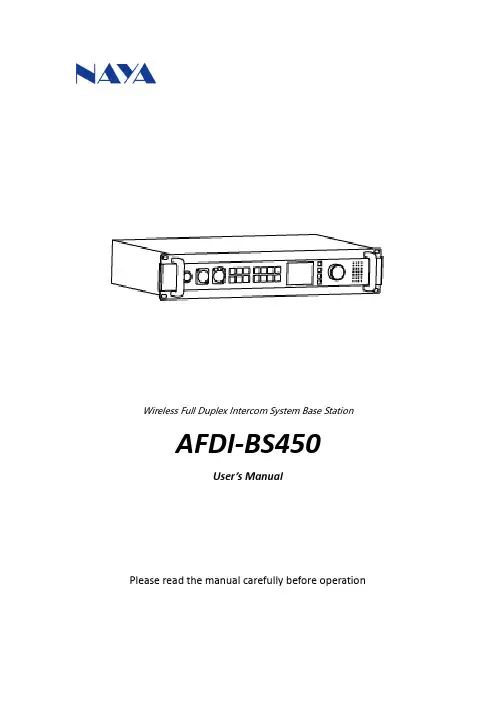
Wireless Full Duplex Intercom System Base StationAFDI-BS450User’s ManualPlease read the manual carefully before operationInterface DescriptionNo. Item Description1 Power button Press the Power button, the button light is on and the device isstarted. Press again the device is turned off.2 Headset interface External cannon-type headset3 MIC interface External gooseneck shaped microphone4Use headphone to speak and listen.Use gooseneck shaped microphone to speakBelt-packs isolated mode. Turn on the button light, all belt-packs areunable to talk with each other except base station.Group mode. Turn on the button light, now the digital keypad numbersindicate group numbers. Each group could talk internally, but unable totalk with other groups.Base station notices belt-packs. The selected belt-packs screen willflash when pressing the key continuously.Base station speaker button. The speaker is turned on when thebutton light is on.Digital keypad(1-8)You can talk to any person or groups no more than 8 at the same timeby pressing certain digital buttons.5 LCD Screen Display related data6 “Confirm” button. Press to enter menu “Up” button. Move left to change data “Down” button. Move right to change data “Exit” button. Exit menu7 VOLUME Adjust volume of the headset/speaker. Screw clockwise to enlargevolume.8 SPEAKER When using a gooseneck shaped or handhold microphone, soundcould be played by SPEAKER.PreparationsStep 1Antenna installation. Install the antenna on the base, then plug the connector into the ANT interface of the base station.Step 2Power cable connection. Plug one end of the power cable connector into the base station power interface, and another end into AC 110/220V power socket.Step 3Headset and microphone installation. Plug connectors of headset and microphone into corresponding interface as required.Step 4 (Please ignore this step if you don’t need tally function)Base station and switcher connection. Plug one end of the tally cable connector into the base station tally interface, and another end into video switcher tally interface.Step 5Turn on the base station. The lights of digital keypad (1-8) will be lit up. Then press or button to speak by headphone or microphone. Press button to turn on the speaker. Adjust the VOLUME knob to a certain level.Step 6Speak by headphone microphone or goose-neck shaped microphone.Topological diagramIntercom SystemNo limit for belt-pack quantity. It supports 8 belt-packs to talk simultaneously.Tally SystemIt supports 12 red and 12 green tally signals. It could support 15 red and 15 green or 32 red tally signals in special situation.Headphone Interface is XLR Male, which connected with headphone.Microphone Interface is XLR Female, which connected with Goose-neck shaped Microphone.Tally Interface is DB25 Male, which connected with common tally cable to receive tally signal from video switcher. It supports 12 red and 12 green tally signals.RS232 Interface is DB9 Female, which connected with RS232 cable to receive RS232 tally signal.UART Interface is 3.5mm socket, which connected with special cable to receive UART tally signal.2W Interface is 3 wire XLR Male for audio signal.Interface Description4W Interface is XLR internet socket for 4 wire audio signal or RS485 communication.AUX IN Interface is 3 wire XLR Female for analog audio input.AUX OUT Interface is 3 wire XLR Male for analog audio signal output.Screen Prompt DescriptionChannelDisplay base station channel. The channel range is 25 - 110.InternetDisplay Internet status. It will be lit up when connected internet.Group ModeDisplay the status of group mode. It will be lit up when group mode is turned on. In this situation, the numbers on digital keypad indicate Group ID. Group mode and belt-pack isolation mode can’t be turned on at the same time.Turn on group mode, one group can’t talk with another group. Each member of group could talk within his group. Base station could talk with all member of any group.If a group ID on digital pad is turned off, the group can’t communicate with the base station. But the member of group could talk within group.Belt-pack Isolation ModeDisplay the status of belt-pack isolation mode. It will be lit up when belt-pack isolation mode is turned on. In this situation, all belt-packs are unable to communicate with each other. Belt-pack isolation mode and group mode can’t be turned on at the same time.Common ModeIt will be lit up if group mode and belt-pack isolation mode are turned off. In this situation, the numbers on digital keypad indicate belt-pack ID. All belt-packs and base station are able to communicate with each other.If a belt-pack ID on digital pad is turned off. The belt-pack can’t communicate with each other. Belt-pack / Group IDDisplay belt-pack ID or group ID that are sending audio signal. It indicates group ID if group mode is turned on. It indicates belt-pack ID if group mode is turned off.If group mode is turned off and a belt-pack microphone is turned on, the belt-pack ID will be lit up. If a belt-pack ID is turned off and the belt-pack microphone is turned on, the belt-pack ID will also be lit up. In this situation, the base station and the belt-pack couldn’t communicate with each other.If group mode is turned on and any belt-pack microphone in the group is turned on, the group ID will be lit up. If a group ID is turned off and any belt-pack microphone in the group is turned on, the group ID will also be lit up. In this situation, the base station and the group couldn’t communicate with each other.SettingsPress the button, the screen will prompt “Press Return Key into menu”. Then press thebutton to enter the menu. Select the following settings by pressing and buttons. Includes Channel Setting, Background Sound Level, Noise Suppression Level, MIC Return, TALLY Setting, two wire setting, Language Setting, Preload configuration, etc. Press button to enter a setting. Press button to return to the previous menu after setting. Press button again to exit menu.Channel SettingEnter the menu and choose “Channel Setting”. Then press “Confirm” button to enter the setting. Choose channel by pressing “Up” and “Down” button. The channel range is 25-110. Press “Exit” button to return to the previous menu after setting.It is advised to set a big channel spacing (30 channels or more) if two or more channels are used for different teams at same place.Each channel represents a certain frequency. Product type 400-470Mhz as below, other type is not same.Channel 25 (412.5MHz)Channel 26 (413MHz)...Channel 109 (454.5MHz)Channel 110(455MHz)Background Sound LevelEnter the menu and choose “Background Sound Level”. Then press “Confirm” button to enter the setting. Choose suitable level by pressing “Up” and “Down” button. There are 3 levels, namely 0, 1, 2. Select the suitable level according to the background noise level. Press “Exit” button to return to the previous menu after setting.The factory default setting is level 1, which is suitable for most situation.Level 0 is suitable for a silent situation, just speak with a low voice.Level 1 is suitable for most situation, you should speak with a loud voice. (Factory default setting) Level 2 is suitable for a noisy situation, you should speak with a roar.(Note: No need to change the setting in general. The voice may be intermittent if the level is too high in a relatively quiet situation)Noise Suppression LevelEnter the menu and choose “Noise Suppression Level”. Then press “Confirm” button to enter the setting. Choose suitable level by pressing “Up” and “Down” button. There are 6 levels, namely 0, 1%, 2%, 3%, 4%, 5%. Choose the suitable level as required. Press “Exit” button to return to the previous menu after setting.The setting allows the headset or speaker to suppress a certain level of the background noise received from other belt-packs or the base station. The default setting is level 5. (Suppress the noise lower than 5%. Only those voice volume surpass 5% will be heard.)MIC ReturnEnter the menu and choose “MIC Return”. Then press “Confirm” button to enter the setting. Choose suitable level by pressing “Up” and “Down” button. There are 10 levels from 0 to 100%. Choose the suitable level as required. Press “Exit” button to return to the previous menu after setting.Turn on the MIC Return function, you can hear your own voice returned by the microphone. Your return voice will be higher with a higher level.It is usually advised to turn off the “MIC Return function”, otherwise it may influence acoustic echo cancellation function.Tally SettingEnter the menu and choose “Tally Setting”. Then press “Confirm” button to enter the setting. Choose switcher brand by pressing “Up” and “Down” button. Then press “Confirm” button to enter video switcher model option. Choose video switcher model by pressing “Up” and “Down” button. Press “Exit” button to return to the previous menu after setting.You should set the right video switcher brand and model, and choose the right switcher cable for the base station to receive switcher tally signal as required. Otherwise the base station may receive the wrong tally signal or even unable to receive tally signal.2 wire SettingEnter the menu and choose “2 wire Setting”. Then press “Confirm” button to enter the setting. Turn on / off the setting by pressing “Up” and “Down” button. Press “Exit” button to return to the previous menu after setting.The default setting is turned off “2 wire Setting”. In this situation, the 2-wire interface is unavailable, and the 4-wire interface is available. If you turn on “2 wire Setting”, the 2-wire interface is available, and the 4-wire interface is unavailable.Language SettingEnter the menu and choose “Language Setting”. Then press “Confirm” button to enter the setting. Switch between Chinese and English by pressing “Up” and “Down” button. Press “Exit” button to return to the previous menu after setting.Quick SettingEnter the menu and choose “Quick Setting”. Then press “Confirm” button to enter the setting. Change the setting by pressing “Up” and “Down” button. Press “Exit” button to return to the previous menu after setting.Keep current Settings: Keep all the current setting data.Restore Factory Settings: Restore all factory data.Quiet Background Settings: All the data will be set automatically to match quiet background. Noisy Background Settings: All the data will be set automatically to match noisy background.Attention1.Router port mapping function is specially designed for Wan connection. The mapping port number is 23458. Please contact network engineer to configure router port mapping.2.Public network IP address must be fixed.Don't use dynamic IP address.3. Please contact the dealer to config proxy server IP address of the base station.Quality Commitment and Maintenance TermsWarranty services for material and manufacturing process defect under normal operation since purchase date.Warranty Scope and Duration12 months for the base station and belt-packs6 months for headphonesWarranty ClaimYou should provide product warranty card or valid purchase invoice to apply repair. The product mark should be kept clean and intact during the warranty period.Warranty CardIn order to protect your benefits, please fill in the following table carefully and keep it properly as a evidence for maintenance.WeChat SubscriptionNumberShanghai NAYA Intelligence T echnologyCo. Ltd.。

数字无线对讲系统介绍数字无线对讲系统是一种利用无线通信技术实现实时语音通信的系统。
它提供了一种便捷、高效的通信方式,适用于各种场景,例如建筑工地、物流仓库、大型活动等。
本文档将介绍数字无线对讲系统的基本原理、功能特点以及应用场景,并提供一些选购建议。
基本原理数字无线对讲系统主要由无线对讲设备、基站和服务器组成。
•无线对讲设备:通常是一种手持式对讲机,通过无线电信号实现用户之间的实时语音通信。
它采用数字信号处理技术,具有更好的语音质量和抗干扰能力。
•基站:基站是系统的核心部件,负责控制和管理对讲设备之间的通信。
它可以连接多个对讲设备,使它们能够相互通话。
•服务器:服务器是系统的数据处理中心,负责存储用户信息、记录通信数据等。
它还可以提供额外的功能,例如通话录音、通话记录查询等。
功能特点数字无线对讲系统具有以下功能特点:1.实时语音通信:支持多人同时通话,实现实时语音通信。
2.高音质语音:采用数字信号处理技术,提供清晰、真实的语音体验。
3.全双工通话:支持全双工通话,用户可以同时发送和接收语音。
4.多频道支持:支持多个频道,用户可以选择合适的频道进行通话。
5.范围广泛:覆盖范围大,适用于各种场景,包括室内和室外。
6.抗干扰能力强:采用数字信号处理技术,具有很强的抗干扰能力。
7.灵活便捷:无绳约束,便于携带和使用。
8.兼容性好:支持与其他品牌的无线设备互联互通。
9.可扩展性强:支持系统扩展,可以根据需要灵活增加设备和频道。
应用场景数字无线对讲系统广泛应用于许多场景,包括但不限于以下几种:1.建筑工地:工地上的人员可以通过对讲机进行实时通话,以提高工作效率和安全性。
2.物流仓库:仓库内的工作人员可以通过对讲机进行即时通信,协调货物存放和调度。
3.大型活动:在大型活动中,组织者可以通过对讲机与工作人员进行实时协调和指挥。
4.旅游景区:导游和游客之间可以通过对讲机进行实时交流,提供更好的导游服务。
5.保安巡逻:保安人员可以使用数字对讲机进行实时通话,加强安全巡逻工作。
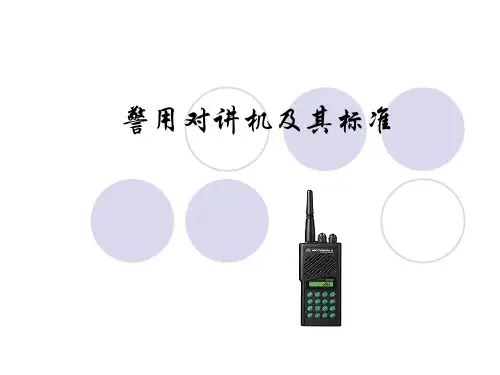
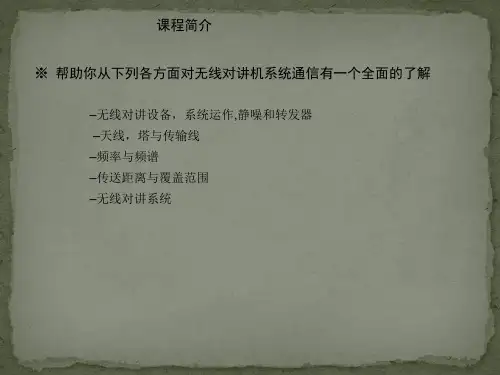

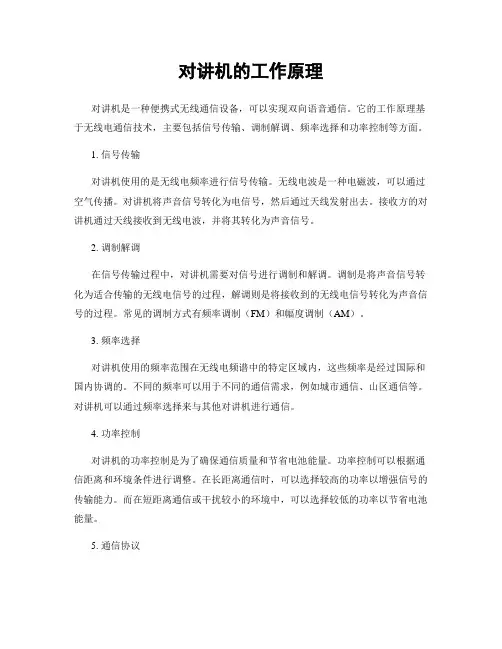
对讲机的工作原理对讲机是一种便携式无线通信设备,可以实现双向语音通信。
它的工作原理基于无线电通信技术,主要包括信号传输、调制解调、频率选择和功率控制等方面。
1. 信号传输对讲机使用的是无线电频率进行信号传输。
无线电波是一种电磁波,可以通过空气传播。
对讲机将声音信号转化为电信号,然后通过天线发射出去。
接收方的对讲机通过天线接收到无线电波,并将其转化为声音信号。
2. 调制解调在信号传输过程中,对讲机需要对信号进行调制和解调。
调制是将声音信号转化为适合传输的无线电信号的过程,解调则是将接收到的无线电信号转化为声音信号的过程。
常见的调制方式有频率调制(FM)和幅度调制(AM)。
3. 频率选择对讲机使用的频率范围在无线电频谱中的特定区域内,这些频率是经过国际和国内协调的。
不同的频率可以用于不同的通信需求,例如城市通信、山区通信等。
对讲机可以通过频率选择来与其他对讲机进行通信。
4. 功率控制对讲机的功率控制是为了确保通信质量和节省电池能量。
功率控制可以根据通信距离和环境条件进行调整。
在长距离通信时,可以选择较高的功率以增强信号的传输能力。
而在短距离通信或干扰较小的环境中,可以选择较低的功率以节省电池能量。
5. 通信协议对讲机通常使用特定的通信协议进行数据传输。
这些协议定义了通信的格式、数据包结构、错误检测和纠正等。
常见的对讲机通信协议有数字对讲机(DMR)、模拟对讲机(Analog)和数字增强通信系统(DPMR)等。
6. 附加功能现代对讲机通常具有一些附加功能,以满足不同的需求。
例如,对讲机可以具备GPS定位功能,以便在需要时能够追踪和定位通信方的位置。
此外,对讲机还可以具备紧急呼叫功能、组呼功能、静噪功能等,以提供更便捷和安全的通信体验。
总结:对讲机的工作原理基于无线电通信技术,通过信号传输、调制解调、频率选择和功率控制等步骤,实现双向语音通信。
它的工作原理简单而可靠,使得对讲机成为许多行业和场景中必不可少的通信工具。
一、系统概述无线对讲覆盖系统的建设是为便利公司管理各部门、保安及操作等人员的日常工作,在紧急或意外事件出现时可以及时对所有相关部门工作人员进行统一的调度和指挥,实现高效、即时的处理,最大的限度减少了可能造成的损失。
由于建筑物对无线电波的屏蔽作用,特别是数据中心的地下室面积较大。
各部位的对讲机接收信号强度不均,对讲系统通话不顺畅,作为解决内部对讲系统的屏蔽作用,改善通话质量是非常必要的,这也是公司管理使用的一个基础系统。
三、需求分析根据上海平高世贸项目的实际需求和图纸情况、公司管理部门使用要求,结合目前无线频率的使用条件,为本项目设计一套420MHz(MOTOROLA / GR1225B)常规无线对讲覆盖系统,并采用三个常规信道,从通信机制上实现了多工作组共享信道的方式来扩大通信容量。
系统设计使信号在公司的公共部位和人员经常活动区域有效地覆盖,使整个系统达到覆盖均匀,信号清晰,稳定可靠。
本设计能够保证以上要求,以满足公司内部管理、使用和维护,以及保安、消防、紧急通信之要求等,使其内部管理、维护以及保安、消防人员之间方便、快捷地保持联系、通讯,达到良好的通讯效果。
现拟采用三套信道主机作为信号源来实现双向无线对讲的要求,设计要求如下:设计的无线对讲系统覆盖的区域为上海平高世贸项目的公共区域,主要设备机房,地下层和周边相邻建筑;设计入网的对讲机发射功率为3瓦,系统天线输出电平为+10dBm,信号在覆盖区域内可测得的场强值不低于-85dBm,话音质量不低于3分效果;天线分布系统设计在吊顶以内,采用无源器件连接,不影响公司装修并能有效降低故障率。
三、概要设计结合对公司无线对讲覆盖的需求分析,本次设计要达到以下要求:在保证系统整体质量及符合国家相关规定的前提下,尽可能降低工程造价成本;尽量考虑施工过程中,原器件安装牢固,馈线的铺设简便、易行,保证施工不破坏公司建筑结构和装修的外观,同时考虑施工比较容易实现及施工效率,确定合理的走线方式;设计中尽量作到室内场强均匀,并有足够的边缘信号强度合理选择天线的类型和规划天线的输出功率及布放位置,使在满足设计要求达到良好的均匀覆盖同时采用的天线数量最少;为建立较完美的无线覆盖网络,在设计时兼顾边缘场强的计算,保证不会产生明显的信号泄漏,同时覆盖网络必须对外界的干扰小,并且不易受到其他同类设备的干扰,不仅要考虑通信的覆盖面,同时也要考虑到无线电干扰的存在性,必须依靠更合理的设计来避免互相的干扰问题。
无线对讲系统无线信号覆盖系统作为移动通信的设备之一,其最大的特点就是系统主要用来解决大型建筑物内部的信号盲区,通过覆盖使信号在有关空间区域内有效,使客户不在受建筑物空间和屏蔽束缚,实现在有效域内的工作协调和指挥调度需求。
由于中西医结合医院建筑物的金属屏蔽以及面积较大,无线电对讲机功率有限,无法满足所有楼层的信号覆盖,所以安全保卫工作无法保证。
应付突发性事件的处理,都离不开快速反应的无线电对讲调度联系。
简单的对讲机通讯远远不能满足管理工作的需要,必须要进一步完善和改造,满足随叫随通,大范围和地下室联系均有保障的通话效果。
因此必须建立一套数字无线对讲覆盖系统,保证无线信号覆盖率达到95%以上。
技术分析数字中继站覆盖无线通讯的解决方案,数字无线通讯系统在优质通信的基础上提供更强大的功能,带来通讯量的提升,频率的有效利用以及综合的数据通信和强大的语音通信。
为建立较完美的无线覆盖系统,在设计时既要兼顾边缘场强的计算,保证天线末端及手持对讲机接收端达到指定的db数值,同时无线对讲覆盖系统必须对外界的干扰小,并且不易受到其他同类设备的干扰,不仅要考虑通信的覆盖范围,同时要达到客户的指定覆盖要求,必须依靠更合理的设计来避免对讲机的信号在传输过程中所经受及产生的各种问题。
1)频率选择:考虑到医院结构所要覆盖区域的特殊性,应选用130-170MHZ或400-430MHZ频段,因为该频段的电波传播有一定的绕射性,并且该频段的抗干扰性较好。
同时该频段也符合国家相关规定。
2)技术指标:无线对讲的呼损率<2%;无线对讲的接通率>98%;无线对讲覆盖区内可接通率:要求在无线对讲覆盖区内的95%位置无盲区覆盖,对讲机所用信道根据客户要求;室内无线对讲覆盖的边缘场强:≥-85dBm,地下室及电梯≥-95dBm;外泄电平(建筑物50 米左右)<-105dBm;覆盖区与周围各建筑内对讲机系统之间无互相干扰。
系统结构系统结构图系统分布图大楼覆盖系统简单示意图系统的基站采用TDMA(时分多址)2时隙工作,节省了频率资源,一组频率相当于模拟中继台的两组频率(配备数字对讲机后两台中继台可同时满足四个部门使用)。
FM调频全双工电梯无线对讲TS-979F全双工电梯无线对讲机系统(三方/五方对讲/三方/五方通话)适用于:社区物业、电梯监控、电梯对讲等特点:快速安装、操作简单、反应迅速、音质清晰A.TS-979F全双工电梯无线对讲系统功能介绍:《楚光金典》电梯无线对讲呼叫系统TS-979F型产品是我公司推出的第四代产品,其单一系统最多可以控制72部电梯进行对讲通话,无需布线,减少了日常使用的维护成本,通话全双工,通话不需要费用,一次性投入终身享用,为管理中心提供了一个全面对讲呼叫的解决方案。
1、通话:当电梯使用过程中发生故障停机或停电困人等意外情况时电梯乘客可轻按“呼叫”键向值班室发出呼叫信号。
2、特点:乘客一键自动报警、语音录音呼叫,无需其它操作;管理中心警声、光键、语音提示呼叫方位与示警;3、优势:一键式呼叫、方便快捷,能有效解决监控中心、机房、轿厢、轿顶、坑底五方对讲通话。
无须布线大量节约了昂贵的线路成本;无须布线大量节约了线路铺设高额的施工成本;大量节约了由于线路故障、老化等因素而带来的维护成本;完全杜绝了由于铺设线路而带来的对楼宇及道路的破坏;监控中心位置可以根据需要任意调整,无需任何线路调整;整个系统施工极为简单、施工周期短、见效快;无线距离覆盖范围广,在3公里半径内抗干扰能力强、音质清晰。
B. TS-979F全双工电梯无线对讲系统布线图C、TS-979F全双工电梯无线三方对讲系统接线示意图D、TS-979F全双工电梯无线对讲机中控系统1.可以单独呼叫每部电梯分机2.可以单独接收每部电梯应答3.可以与每部电梯无线双向对讲4.可以同时向所有电梯发出广播通知5.可以控制对讲方式与对讲进程6.所有电梯对讲系统完好性自动巡检功能7.故障电梯信号灯位置指示功能8.故障电梯呼叫时,防被中断保护9.对讲状态信号灯提示功能10.专用UPS充电电源,停电后可依然长时间持续工作11.具有无线距离远及非常强的抗屏蔽性能12.抗干扰能力强及无线对讲语音非常清晰E、TS-979F全双工电梯无线对讲机转发分机功能1. 呼叫语音录制功能2. 一键自动报警呼叫3. 自动内置语音呼叫4. 自动应答回呼主机5. 防止反复循环呼叫6. 无线双向对讲7. 工程接口齐全8. 抗屏蔽性能强无线距离远9. 抗干扰能力强,语音清晰GSM卡电梯无线对讲TS-757电梯无线(GSM)对讲系统适用于:社区物业、电梯监控、电梯对讲等特点:快速安装、操作简单、反应迅速、音质清晰A.TS-757电梯无线对讲系统介绍:TS-757型电梯无线对讲产品无须布线即可连接多台电梯使其轻松实现对外通话。
某厂区无线集群对讲系统说明书某厂区无线集群对讲系统说明书一、系统概述某厂区无线集群对讲系统是一种基于无线通信技术和互联网技术的企业内部通讯系统,主要目的是提供高效、方便的语音通讯服务。
该系统可在厂区内的各个区域实现实时、双向的语音通讯,支持群组通讯和个人通讯,具有通话质量高、覆盖范围广的特点。
二、系统结构1. 系统主要组成部分(1)无线对讲机:负责与用户进行语音通讯,支持单呼、组呼、全呼等通讯方式。
(2)对讲服务器:负责管理无线对讲机的注册、组管理和通话调度等功能。
(3)网络交换设备:提供无线对讲机与对讲服务器之间的数据传输通道。
(4)互联网接入设备:提供系统与互联网的连接通道,实现远程通讯功能。
2. 系统工作原理首先,无线对讲机通过无线信号与网络交换设备进行连接,然后通过网络交换设备与对讲服务器进行数据通信。
当有用户需要进行语音通讯时,无线对讲机向对讲服务器发送请求,在对讲服务器的调度下进行语音通话。
三、系统功能1. 群组通讯用户可以加入不同的群组,实现群组内的语音通讯。
群组成员可以同时进行语音对讲,实现快速、高效的信息传递。
2. 个人通讯用户可以通过个人对讲机与其他用户进行一对一的语音通讯。
这样,用户之间可以进行私密通讯,保护隐私。
3. 语音录制系统支持对通话内容进行录制,用户可以在需要的时候进行回放。
这样,可以解决信息传递不准确或遗漏的问题。
4. 呼叫转移用户可以将呼叫转移给其他用户,实现通讯的无间断传递。
5. GPS定位系统支持GPS定位功能,可以对用户进行实时定位。
这样,可以提高工作效率和安全性。
6. 远程监控系统支持远程监控功能,管理人员可以通过互联网接入设备对系统进行远程监控和管理。
这样,可以及时发现并处理系统故障。
四、使用说明1. 系统入口用户需要使用个人账号和密码登录系统,在登录成功后才能使用系统的各项功能。
可以在无线对讲机上输入账号和密码进行身份验证,也可以在电脑或手机上使用相关软件进行登录。
双向无线对讲系统在隧道内设备安装阶段的使用方法摘要:现代工程多采用各种智能化设备,它们共同构成了现代化工程辅助体系,在施工的各个阶段发挥着不可取代的重要作用。
双向无线对讲系统就是体系中的重要一员,本文探讨了该系统基本工作原理与系统设计应用组成,同时着重分析它在隧道工程内设备安装阶段的正确使用方法。
关键词:双向无线对讲系统;系统设计;隧道内设备安装;使用方法现阶段我国城市轨道交通建设规模逐渐扩大,大量的地下隧道工程在城市中被贯通建设,考虑到地下隧道建设的特殊性,其较长的地下施工区间可能无法实现对地面通讯的快速有效联系,所以采用新设备系统解决这一问题,提高施工效率是非常有必要的。
目前的双向无线对讲系统就能满足这一要求,它的通讯技术性能优越,解决了现实中所存在的地上地下通讯问题。
一、隧道内施工采用双向无线对讲系统的原因目前我国城市地下隧道区间较长,施工情况相对复杂,如果地下区段超过2km,隧道内施工人员若想实现与地面联系就必须走出隧道,相当麻烦。
一般来说,在地下隧道行走1公里至少需要15~20分钟左右,再加上返程时间翻倍,其为与地面联系所消耗的时间会大幅度降低地下隧道施工效率,得不偿失。
所以当前缺乏地下隧道施工有效沟通手段是一大现实难题,特别是在遭遇地下隧道突发情况时如果不能做到第一时间沟通,将严重影响救援效率,错失最佳的救援时机而导致人员财产损失。
为了解决这一问题,我国中铁电气化局集团公司也专门组织技术人员专门研发了地下隧道施工用双向无线对讲系统。
二、双向无线对讲系统的工作原理与系统设计组成目前最先进的双向无线对讲系统采用了网络视频监控模式,满足了视频对讲条件,能够很好实现数据线路传输,确保信号传输稳定性。
它就希望解决传统地下隧道施工中通讯设备功能的局限性问题,规避掉了大量的布线工作,确保隧道内设备安装阶段工作的顺利展开,同时也为突发情况下的救援工作有效展开赢得了大量宝贵时间。
(一)系统设计组成双向无线对讲系统主要由软硬件两部分系统共同组成,其中硬件作为基础部分存在,而软件则要发挥主导性作用功能,有效控制硬件工作顺利展开。